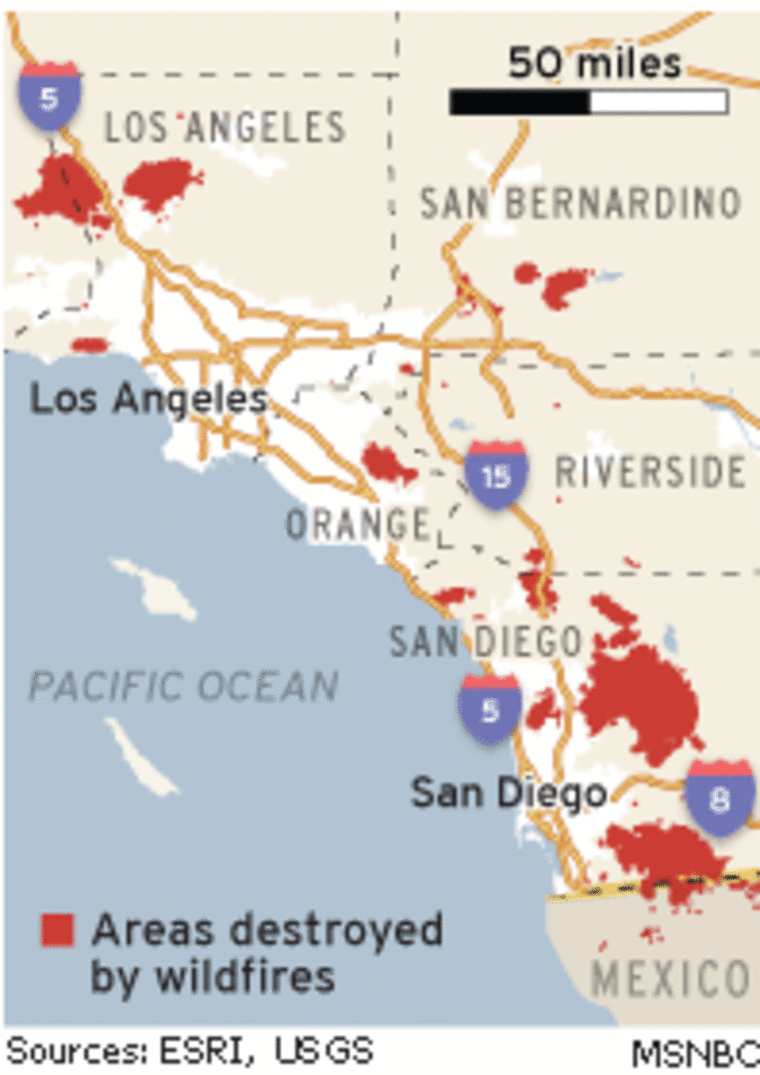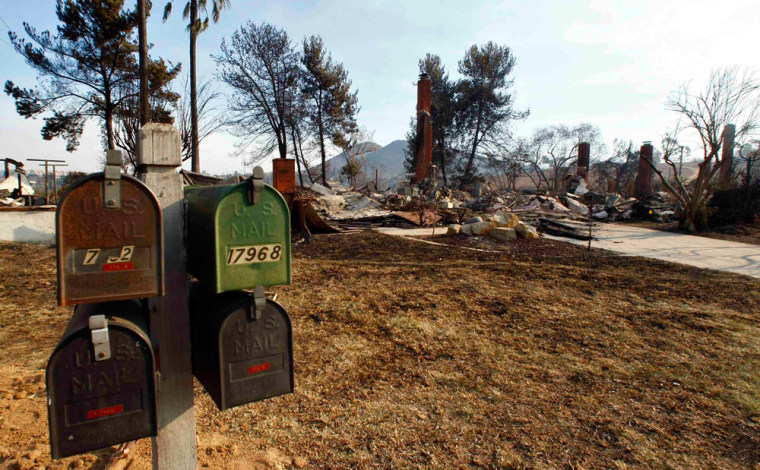As winds eased and firefighters gained ground, special FBI teams gathered evidence Wednesday as part of an arson investigation into the wildfires devastating Southern California, the agency said.
FBI evidence response teams recovered materials they hoped would identify the source of the fires that have burned for four days. Correcting an earlier report, the FBI said a house was not searched as part of the investigation.
Richard Kolko, an FBI spokesman in Washington, said the evidence response teams “have been working with other federal, state and local authorities” to identify the source of the fires.
Late Tuesday, police shot and killed a man who fled when officers approached to see if he might be trying to set a fire.
San Bernardino police said the man was shot following a chase that ended when the unidentified Arizona man backed his car into a cruiser and an officer opened fire.
On Wednesday, a man accused of setting a small brush fire in a rural foothill area of the San Bernardino Mountains was booked for investigation of arson. However, San Bernardino County sheriff’s spokeswoman Cindy Beavers said authorities don’t know if he is connected to any of the region’s wildfires.
Firefighters had fully contained three major fires in Los Angeles County by nightfall, and largely contained many of the fires north of San Diego.
Despite the progress, none of the six major blazes in San Diego County was more than 15 percent contained, and those fires threatened more than 8,500 houses. The top priority was a fire in San Bernardino County that threatened 6,000 homes and continued to rage out of control.
Bush signs disaster declaration
The devastating blazes have caused at least $1 billion in damage in San Diego County alone, officials said Wednesday, as the easing wind gave firefighters hope.
The fires have destroyed 1,500 homes and caused at least a half-million people to flee — the largest evacuation in state history. At least 1,200 of the damaged homes were in San Diego County, and officials believe that number will rise.
“Clearly, this is going to be a $1 billion or more disaster,” Ron Lane, San Diego County’s director of emergency services, told reporters during a news conference.
The announcement of San Diego’s staggering losses came as President Bush signed a major disaster declaration for California in the wake of the wildfires that have charred about 426,000 acres, or about 665 square miles.
The declaration puts in motion long-term federal recovery programs to help state and local governments, families, individuals and certain nonprofit organizations recover. Bush plans to visit the state on Thursday.

“Americans all across this land care deeply about them,” the president said after a Cabinet meeting convened to coordinate federal relief efforts. “We’re concerned about their safety. We’re concerned about their property.”
The fierce Santa Ana wind that has stoked the explosive blazes started to moderate Wednesday although stiff gusts continued to blow through some canyon areas. Forecasters said the wind eventually would be followed by cooling sea breezes.
Wind gusts slow
Wind was reported blowing at a sustained speed of 21 to 36 mph in some areas Wednesday, considerably less than the gusts of up to 100 mph earlier in the week.
The shift could allow for a greater aerial assault and help firefighters beat back the most destructive blazes, said Homeland Security Secretary Michael Chertoff.
An unmanned NASA aircraft outfitted with high-tech imaging equipment took off Wednesday from Edwards Air Force Base on Wednesday for a 10-hour flight to help firefighters locate hot spots. Pilots at NASA Dryden Flight Research Center were remotely controlling the aircraft, outfitted with a thermal-infrared imaging system capable of seeing through thick smoke.
Crews also were anticipating additional firefighters and equipment from other states, mostly throughout the West. Frustration over the firefighting effort began to emerge Tuesday when a fire official said not enough had been done to protect homes.
Orange County Fire Chief Chip Prather told reporters that firefighters’ lives were threatened because too few crews were on the ground. He said a quick deployment of aircraft could have corralled a massive blaze near Irvine.
“It is an absolute fact: Had we had more air resources, we would have been able to control this fire,” he said.
Governor: Criticism unfounded
The state’s top firefighter said Prather misstated the availability of firefighters and equipment. Eight of the state’s nine water-dumping helicopters were in Southern California by Sunday, when the first fires began, along with 13 air tankers, said Ruben Grijalva, director of the California Department of Forestry and Fire Protection. Grijalva said the fires would have overwhelmed most efforts to fight them.
“Anyone that is complaining about the planes just wants to complain because there’s a bunch of nonsense,” Gov. Arnold Schwarzenegger told ABC News. “The fact is that we could have all the planes in the world here — we have 90 aircraft here and six that we got especially from the federal government — and they can’t fly because of the wind situation.”
Twenty-one firefighters and at least 24 others have been injured. One person was killed by the flames, and the San Diego medical examiner’s officer listed five other deaths as connected to the blazes.
Agonizing wait
Thousands of people remained in emergency shelters, where many had an agonizing wait to find out whether their homes had survived.
“I’m ready to go, but at the same time, I don’t want to go up there and be surprised,” said Mary Busch, 41, who did not know whether her home in Ramona, in San Diego County, was still standing. She has lived at the evacuation center at Qualcomm Stadium since Monday, sleeping in her SUV with her 11- and 8-year-old sons.
Some knew their homes were destroyed. Mike and Tere Miller of Rancho Bernardo were able to return Tuesday. They had left frantically when they realized flames were approaching, stopping only to drag their dog out the door and awaken a handicapped neighbor. When they came back, they kept looking for their home — and never saw it.
”It was just a smoldering pile of nothing,” Mike Miller told NBC’s show.
His wife said she had packed papers they knew they would need, but that was it. “If you even think that something’s going to happen, you should prepare, and consider all the things that are most meaningful to you. Because once they’re gone, you can never get them back,” she said tearfully.
Some evacuation orders lifted
Others were eager to return to houses they were confident had survived.
“I called my home and my answering machine still works, so that’s how I know we’re OK,” said Rancho Bernardo resident Fuli Du, who packed his belongings Wednesday preparing to leave Qualcomm.
He spent his 41st birthday Tuesday at the stadium, where he has been staying with his wife and two young sons.
More evacuation orders were issued Wednesday. Residents of the San Diego County communities of Fallbrook and Julian, an area devastated by a 2003 wildfire, were ordered out of their homes. Officials also were evacuating De Luz, an unincorporated community north of Camp Pendleton that was being threatened by a wildfire on the Marine base. The fire also closed Interstate 5 and the Metrolink commuter rail, snagging the morning commute.
However, residents were allowed to return to some areas of San Diego County including Carlsbad, Chula Vista, Del Mar, Encinitas and Solana Beach.
“There are some hot spots and issues there, but we wouldn’t be letting people go back if it weren’t safe,” county spokeswoman Lesley Kirk said.
The city of San Diego was assessing whether to allow people to return to their homes in Rancho Bernardo, one of the hardest-hit areas, Mayor Jerry Sanders said.
So far, the fires have inflicted the worst damage in San Diego County, where five blazes continued to burn. The largest fire had charred 196,420 acres — about 300 square miles — from Witch Creek to Rancho Santa Fe, destroying 650 homes, businesses and other buildings. Other hard-hit areas included San Bernardino County, where hundreds of homes burned in the mountain resort communities near Lake Arrowhead.
